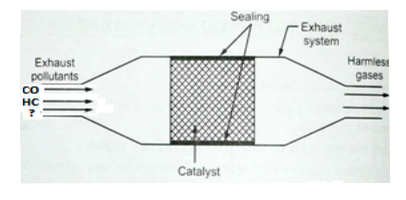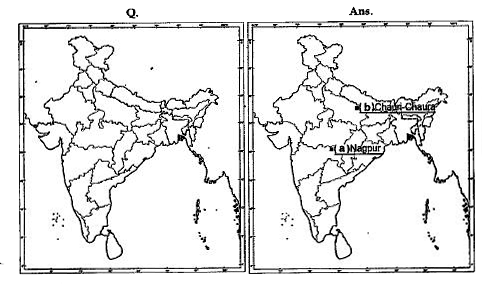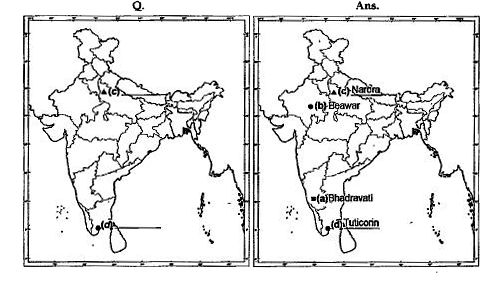Examine any two evidences found by the archaeologist B.B. Lal after excavation at a village named Hastinapur in Meerut, Uttar Pradesh.
In 1951-52, the archaeologist B.B. Lal excavated at a village named Hastinapura in Meerut (Uttar Pradesh). While the similarity in names could be coincidental, the location of the sites in the Upper Ganga Doab, where the Kuru kingdom was situated, suggests that it may have been the capital of the Kurus. Lal found cvidence of five occupational levels, of which the second and third are of interest to us. Lal noted about the houses in the second phase that within the lirnited area excavated, no definite plans of houses were obtained, but walls of mud and mud-bricks were duly encountercd. The discovery of mud-plaster with prominent reed-marks suggested that some-of the-houses had-ceed walls plastered over the mud. For the third phase, Lal noted that houses of this period were built of mud-bricks as well as burnt bricks. Soaked jars and brick drains were used for draining out refuse water, while terracotta ring-wellsmay-have tbeen-ense both as-welle-and- drainage pits.
Topper's Solved these Questions
- BOOK - XII BOARDS PREVIOUS YEARCHAPTER - OUTSIDE DELHI 2019EXERCISE - OUTSIDE DELHI 2019 - SET II7videos
OUTSIDE DELHI 2019
- BOOK - XII BOARDS PREVIOUS YEARCHAPTER - OUTSIDE DELHI 2019EXERCISE - OUTSIDE DELHI 2019 - SET III2videos
OUTSIDE DELHI 2019
- BOOK - XII BOARDS PREVIOUS YEARCHAPTER - OUTSIDE DELHI 2017EXERCISE - OUTSIDE DELHI 2017 - SET III5videos
OUTSIDE DELHI 2017
Similar Questions
Knowledge Check
- Question 1 - Select One
Which of the following are incorrect statements?
A. The archaeological evidence is obtained by the systematic examination of building monuments and work of art.
B. The credit for excavating the Pre-Aryan past goes to Sir William Jones.
C. The Asiatic Society of Bengal established on 1786.
D. James Mill is known as the Father of Indian ArchaeologyAA and BBC and DCB and DDB, C and D
Solution A turns universal indicator blue to purple whereas solution B turns universal indicator orange to red.
(a). What will be the action of solution A on litmus?
(b). What will be action of solution B on litmus?
(c) Name any two substances which can give solutions like A.
(d). Name any two substances which can give solutions like B.
(e). What sort of reaction takes place when solution A reacts with solution B?View SolutionAnswer the following :
(a) Name of the element not known at time of Mendeleev.
(b) Name any two typical elements.
(c ) Name any two bridge elements.
(d) Name two pairs showing diagonal relationship.
(e) Name two transition elements.
(f) Name two are rare earth elements.
(g) Name two transuranic elements.
(h) In which case compounds of Cr show maximum radius.
(i) K2CrO7, (ii) CrO2Cl2 , (iii) Cr2(SO4)3
(iv) CrCl2View SolutionAnswer the following :
(a) Name of the element not known at time of Mendeleev.
(b) Name any two typical elements.
(c ) Name any two bridge elements.
(d) Name two pairs showing diagonal relationship.
(e) Name two transition elements.
(f) Name two are rare earth elements.
(g) Name two transuranic elements.
(h) In which case compounds of Cr show maximum radius.
(i) K2CrO7, (ii) CrO2Cl2 , (iii) Cr2(SO4)3
(iv) CrCl2View SolutionName any two disaccharides which involve B-linkages.
View Solution
Observe the diagram of the catalytic converter and answer the questions which follow:
(a) Name any two metals used as catalyst in the catalytic converter.
(b) Name the gases that are released after passing the exhaust hydrocarbons through the catalytic converter.
(c) Name the other poisonous gas which is missing (?) in the exhaust pollutant of an automobile in the above diagram?View Solution
Observe the diagram of the catalytic converter and answer the questions which follow:
(a) Name any two metals used as catalyst in the catalytic converter.
(b) Name the gases that are released after passing the exhaust hydrocarbons through the catalytic converter.
(c) Name the other poisonous gas which is missing (?) in the exhaust pollutant of an automobile in the above diagram?View Solution(A) Locate and label the place on the given outline political map of India:
(a) The place where the Indian National Congress Session was held in December, 1920. 1
(b) The place where 22 policemen were burnt forcing Gandhiji to call off the Non cooperation Movement.

(B) The following features are to be located and labelled on the given India political outline map:
(a) Bhadrawati – Iron and Steel Plant
(b) Beawar-Mica Mine
Identify the features marked on the same given India political map and write their, names:
(c) Nuclear Power Plant
(d) Major Sea Port

(a) Name the place where the Indian National Congress session was held in December, 1920.
(b) Name the place where 22 policemen were burnt forcing Gandhiji to call off the Non-cooperation Movement.
(c) Name the nuclear plant located in Uttar Pradesh. (d) Name the iron and steel plant located in Chhattisgarh. (e) Which is the southernmost sea port of India?View Solution

